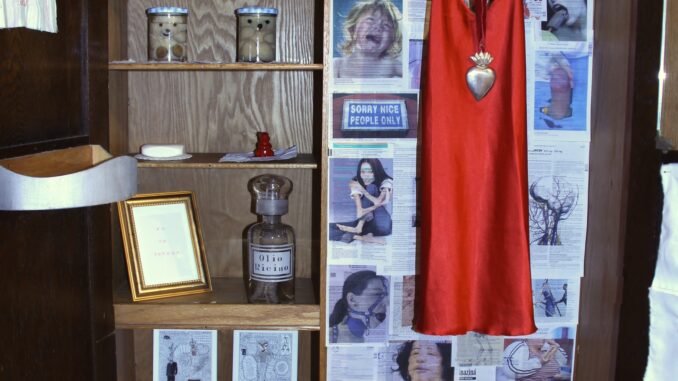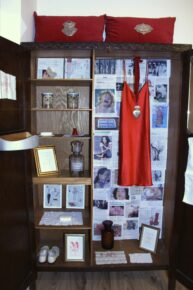

Annie. You have a theatre arts and law background and you work as freelance producer and project manager for arts projects as well as creative producer and filmmaker. On top of that, you are the director of Brockspace, a new pop-up arts venue in Southeast London. This is truly impressive! Tell me more about your practice and the kind of projects you have been producing over the past years.
Gosh, thanks, but the word ‘practice’ makes it all sound so unified when the route has been more exploratory and circuitous. After my degree I was teaching at Goldsmiths for a few years while doing some postgraduate research in cultural theory and film. Then a friend advised me to get some real world skills, so I got a legal qualification and did some time working at a law practice. But my interest has always been in the arts, so I kept on working on varied projects, from music videos, short films to promos, to even a feature documentary that never saw the light of day. When I started working as a producer with The Light Surgeons, I worked on two projects that resonated with me in particular. Domestic Archaeology at the Geffrye Museum and Articulated London at the Oxo Bargehouse. The ideas explored in those exhibitions – the idea of home, belonging, identity, the city, places, people and their stories – are all strands which now thread through the work I do. I just finished Badger, an animated short documentary film set in Brockley, which deals with the artist’s story of creativity and mental health. I’m also currently working on a project developed from the stories of women who grew up under different socio-political regimes.
With Anna Viani, Mirabelle Spreckelsen, Nobuhiro Kobayashi and Simone Ruth, you founded Something Human. An international curator-collective that brings together architecture, design, sculpture, mixed media, moving image and performance. How does an international platform like Something Human work? How does setting up events and projects with art professionals based in different countries impact the collective decision process?
Something Human was based on the shared understanding that we are all transplants in a world where travel and migration are increasingly commonplace and frequent. From this, we understand and struggle with notions of duality, ambivalence, transience, being caught between several places in the imagination and reality. We are also incredibly curious about exploring. We bring this understanding and perspective to our work.
On a practical level, it is still a work-in-progress experiment. We work with regular face-to-face meetings when we can, skype conferences, shared google docs and other online tools. Sometimes the process is hilarious and even painful – with two people on skype, one typing via Facebook, and another on gchat or texting. But our experiences mirror anyone’s who’s ever multi-tasked on a computer, whether it’s talking to friend on IM, emailing and also using voip or something while gaming. But I think all these practices are based on the valuing of conversation and exchange of ideas, regardless of the platform, and trusting that when decisions have to be made quickly, that they reflect a shared concern over the issues in the project.
Brockspace is a very interesting concept: a flat in Southeast London, a former Victorian terrace that became an arts space. What does it mean for you to cross its threshold? What does Something Human want this space to be?
Even though we tried to empty the flat as much as we could for W I T H (OUT), we realized that the space itself had very strong connotations of home, of something cozy and shared. To that, we found it worked well with another desire we shared, which was to take artwork out of the institutional space and place it not in a blank space, but a space where people inhabit, where they interact with each other and with art.
Brockspace, by its nature, is a residential space, but through our projects, we are also opening the home space to being a “guest space”, a space where we invite the public to come in and be guests, and engage in conversation and exchange with us.

Until 8th December, Brockspace hosts W I T H (OUT). A multimedia exhibition that investigates the relation between the ‘interior and the exterior that plays out over issues such as identity, borders and migration, belonging and longing, the tensions of navigating between the different spheres’. Is this a way of widening the meaning of ‘home’? Tell us more about the artists involved and how they replied to your call.
We started with an understanding that the notion of “home” was itself not fixed – it is also changeable, contingent and fragile. We can feel at home at unexpected times, perhaps it’s with the right company, perhaps it’s a moment of familiarity and identification. Also, there is an intrigue with how the notion of home can be in a state of flux, and possibly fractured from within, quite easily too, whether it’s by loss or intrusion, and yet can be reconfigured again, though differently.
The artists we are working with in this exhibition work across very different media and approaches. For example, we have three artists showing photography though with very different approaches. John Clang is a photographer and artist originally from Singapore, now based in the US. We are showing the photographs and video from his innovative take on the “family portrait”, which is now mediated through Skype as families are now quite commonly split up across the world. Bianca Brunner is also showing two of her photographic works, which are by contrast, more formal and beautiful in their approach, whereas Gloria Houng’s works are cleverly staged and play with the idea of images within images. We also have artists working with ceramics, graphical representations, mixed media, luggage sculptures, moving image etc. We were also delighted that Penzo+Fiore came over from Venice to perform a live happening during the preview. Right now, I’m currently with artist, Pablo Anton from Navarre, who is installing an interactive site-specific work in the bathroom.
By and large, the artists have been excited by the ideas in the show and been incredibly responsive to us, so we’re very grateful.
W I T H (OUT) is going to be on tour throughout Europe and Asia, what route will the exhibition take? What are Something Human’s plans for the coming months?
We’re still trying to decide the route. It is partially dependent on the spaces we’re working with, and we’re also throwing up some discussions about how these routes should be taken and what modes of travel should be used. Apart from that, we’re also working on an online curation aspect of our work, and also dreaming about a new project for next summer.

Leave a Reply